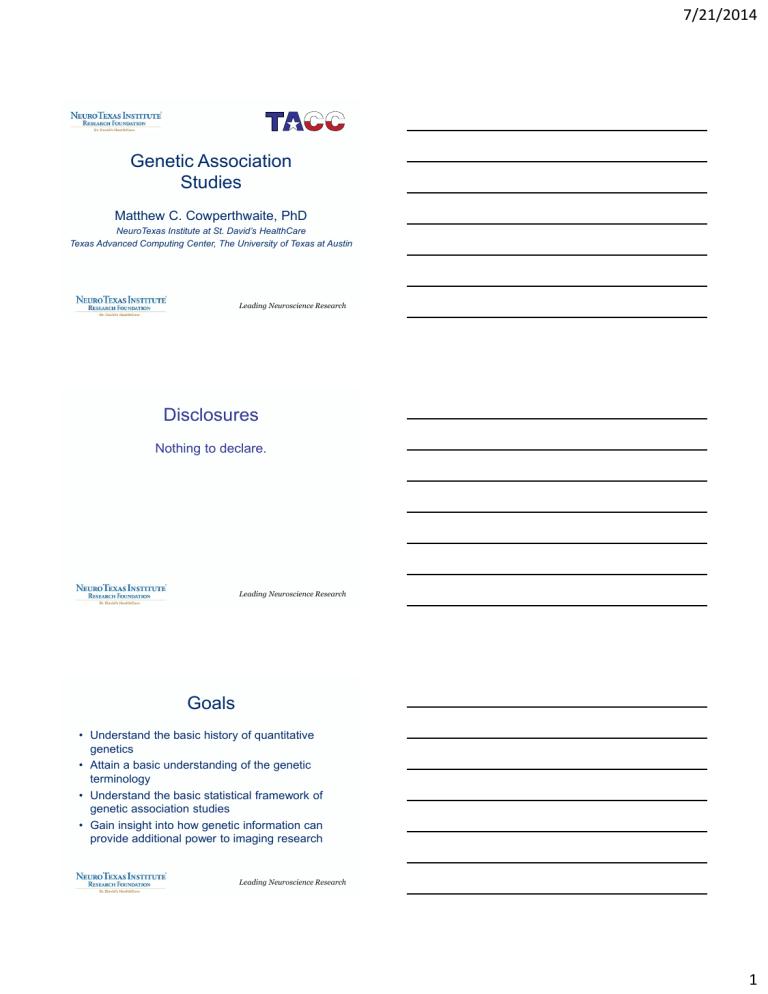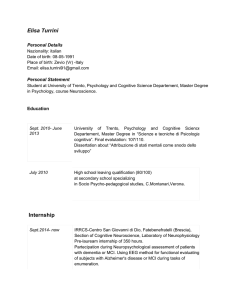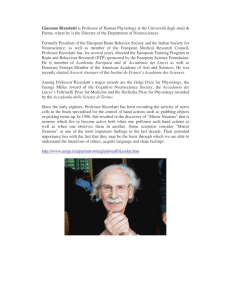Genetic Association Studies 7/21/2014 Matthew C. Cowperthwaite, PhD

Genetic Association
Studies
Matthew C. Cowperthwaite, PhD
NeuroTexas Institute at St. David’s HealthCare
Texas Advanced Computing Center, The University of Texas at Austin
Leading Neuroscience Research
Disclosures
Nothing to declare.
Leading Neuroscience Research
Goals
• Understand the basic history of quantitative genetics
• Attain a basic understanding of the genetic terminology
• Understand the basic statistical framework of genetic association studies
• Gain insight into how genetic information can provide additional power to imaging research
Leading Neuroscience Research
7/21/2014
1
The Dawn of Genetics
Traits
Leading Neuroscience Research
Discrete traits
Quantitative traits
Leading Neuroscience Research
A Great Debate
Are the mechanisms of inheritance the same?
Discrete
Continuous
Mendelians
Traits evolve by few large mutations
Biometricians
Traits evolve by many small mutations
Leading Neuroscience Research
7/21/2014
2
Genetic Terminology
Human Karyotype
Flower Color Gene
Purple Allele White Allele
Gene := heritable “unit”, corresponding to region of DNA (the locus )
Allele := specific form of a gene, i.e. variant
Height Gene
A
1
A
2
60 65 70 75 55
Leading Neuroscience Research
Single Nucleotide Polymorphisms
A
G
Single-base mutation at a locus
Polymorphic – variant is segregating in the human population
Leading Neuroscience Research
Many SNPs in the Human Genome
SNP Density
• ~ 10M
• Segregating (polymorphic) in the human population
• common = > 1-2%
• Not uniformly distributed (red regions have elevated SNP density)
Leading Neuroscience Research
7/21/2014
3
Surveying the Genome with Tag
SNPs
Recombination
Linkage Dysequilibrium
• Non-independent inheritance
Tag SNPs
• SNPs that represent regions of high
LD
SNPs r 2 = 1
Leading Neuroscience Research
GWA Studies
Classic genetic linkage analysis
Genome-Wide
Analysis
• Low throughput
• Bias – geneticist often looking at one (or a few) genes with some prior knowledge
• High throughput
• Less bias – survey SNPs that represent most of the genome
Leading Neuroscience Research
SNP:Disease Associations
NHGRI GWA Catalog www.genome.gov/GWAStudie s
Leading Neuroscience Research
7/21/2014
4
SNP Genotyping
Microarray-based Assays
(“chips”)
Affymetrix GenomeWide 6.0
~ 1 M tag SNPs
DNA Sequencing-based Assays
Illumina HumanHap 550
~ 1 M tag SNPs
Leading Neuroscience Research
Sequencing Based SNP Discovery
Next-Gen Sequencing (NGS)
• Costs are plummeting
• Exome (all protein coding genes) ~ $2K
• Whole Genome ~ $6-8K
In a sequencing based method, we sequence genomes or genes of interest and compare our sequence data to known databases of variation
Leading Neuroscience Research
Arrays versus Sequencing
• “Chips”
– Cheaper (for now…)
– Survey common variants (> 2% within population)
– Not identifying the causal variant(s); most introns and intergenic
• Sequencing
– Identify common and rare variants
– May identify new mutations and causal variant(s)
– Can also get coding sequence of many genes
Leading Neuroscience Research
7/21/2014
5
GWA Study Design
• Trait or phenotype of interest
– Discrete – categorical or case-control study
– Continuous – quantitative study
• Power to detect significant associations
• Chip-based assay or NGS genotyping
Leading Neuroscience Research
GWAS Power
Large multiple-testing load:
• Bonferroni:
• FDR and derivatives:
Image of typical Affymetrix
GW6.0 hybridization
~ 1M SNPS, 11X redundancy
Overcoming the load:
• Large N, but expensive and timeconsuming
• Test fewer SNPs, for example twostage GWAS
Leading Neuroscience Research
Array Data Processing
Patient Cohort Raw Genotype
Data
T
Intensity
Pre-processing
• Normalization
• Signal correction
• Signal extraction
Genotyping
C
C
T
T
T
C
T
C
C
T
C
C
C
T
C
C
Affy: Birdsuite
Illimuna: BeadStudio
Leading Neuroscience Research
7/21/2014
6
Additional Data Considerations
• Genotype curation
– Missingness
– Hardy-Weinberg
Equilibrium
– Odd Mendelian
Inheritance Patterns
• Population
Stratification
Principal Components
Analysis of SNP Data
PC1
GWAS Study Design: Case-Control
C C
T
C
C
C
C C
T
C
Cases
(affected with some disease)
C
T
T
C
T
C
T
C
C
T
Controls
(not affected)
C
T
Case
8
2
Control
5
5
Leading Neuroscience Research
Case-Control Statistics
• Count frequency of each allele in case and control population
• Only identify significant differences in frequency
• No models of dominance, recessiveness, etc.
C
T
Case
16
4
Control
10
10
Chi-Square Test
Fisher’s Exact Test
7/21/2014
7
Case-Control Statistics
• Model frequencies of genotypes
• Can model interactions between alleles (e.g. dominance)
C/C
C/T
T/T
Case
6
3
1
Control
3
4
3
Cochran-Armitage Trend Test
Case-Control Statistics
• Modeling probability of case
• Potential for prediction and/or classification
• Covariates can be included
1
0
Logistic Regression
Genotype
Quantitative Association Studies
QTL: Quantitative Trait Locus
SNPs
High LD
Expression Level eQTLs
Imaging Features
Leading Neuroscience Research
7/21/2014
8
Quantitative GWAS Statistics
Spearman’s correlation
Coefficient ( rho )
AA
0
AC
1
Genotype
CC
2 d i
= difference in ranks between genotype and trait values
Leading Neuroscience Research
Quantitative GWAS Statistics
Linear Regression
AA
0
AC
1
Genotype
CC
2
• Models
• Covariates
• Perhaps less robust
Leading Neuroscience Research
GWAS Software
• Pre-processing:
– Affy PowerTools/Birdsuite @ Affymetrix
– Illumina BeadStudio for Illumina data
– RMA adjustment – many implementations in MATLAB,
R/Bioconductor, and more
– Eigenstrat - http://genetics.med.harvard.edu/reich/Reich_Lab/Software.html
• Associations
– PLINK: http://pngu.mgh.harvard.edu/~purcell/plink/
– GWASTools: http://www.bioconductor.org/packages/devel/bioc/html/GWASToo ls.html
– Merlin: http://www.sph.umich.edu/csg/abecasis/merlin/index.html
Leading Neuroscience Research
7/21/2014
9
GWAS Data
• Raw data:
– dbGAP: http://www.ncbi.nlm.nih.gov/gap
– dbSNP: http://www.ncbi.nlm.nih.gov/SNP/
– Other repositories:
• NIH validated: http://gds.nih.gov/02dr2.html
• ADNI: http://www.adni-info.org/
• TCGA: http://cancergenome.nih.gov/
• Ask researchers for source data…
• Meta-data
– GWAS Catalog: http://www.genome.gov/gwastudies/
Leading Neuroscience Research
Alzheimer’s Disease
• Most common form of dementia
– Familial – defects in
APP processing
– Sporadic – mutations in APOE-4, CLU, CR1,
…
• Loss of memory and other cognitive functions
Image: www.alz.org
Identifying Risk Factors for
Alzheimer’s Disease
• Diagnostic image-based biomarkers for development of AD
• Identifying genes and pathways that can improve power of imaging biomarkers
• Improve CAD systems for early detection and tracking progression of Alzheimer’s disease
Leading Neuroscience Research
7/21/2014
10
AD Imaging Genomics
Extracted Features
MRI
Images
Genetics
Statistical
Models
Actionable information for physicians
Leading Neuroscience Research
Image-Genomics Study
• Meta-analysis of AD GWAS studies identified10 candidate genes
– Replicated in multiple studies
– APOE/TOMM40, ABCA7, BIN1, CD2AP, CD33,
CLU, CR1, EPHA1, MS4A4/MS4A6A, PICALM
– 66 candidate SNPs
• Quantitative phenotypes
– Imaging features (e.g. hippocampus volume)
– CSF biomarkers
Leading Neuroscience Research
Example Associations
Gene SNPs Imaging Feature
ESR1 (Estrogen receptor 1) rs9341052, rs9341052 Ventricular enlargement
BIN1 (Bridging integrator 1) rs17014923, rs749008
Third-ventricle enlargement
SORCS1 (Sortilin-related
VPS10 domain receptor 1)
EPHA1 (EPH receptor A1) rs6584777 rs4726618
Left-inferior lateral ventricle enlargement
Left-inferior lateral ventricle enlargement
Leading Neuroscience Research
7/21/2014
11
Acknowledgements
Mia Markey Nishant Verma
Blake Printy
Leading Neuroscience Research
Matthew C. Cowperthwaite, PhD
matthew.cowperthwaite@stdavids.com
(512) 544-8059
For more information: www.ntiresearch.org
Leading Neuroscience Research
7/21/2014
12

